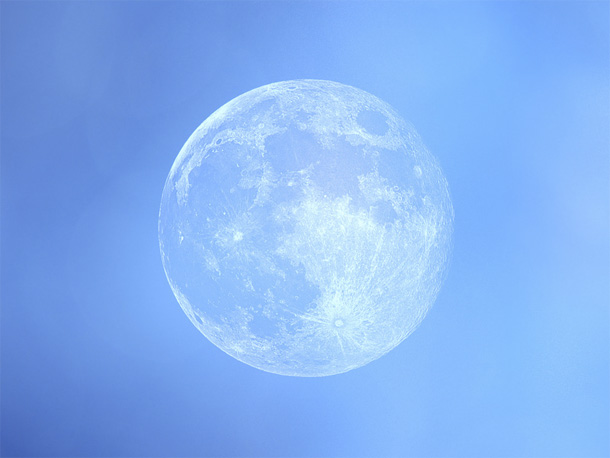
“When the two disappear into the one, where does the one go?” So asks the elusive Zen koan that serves as a starting point for this thoughtfully staged exhibition at the Zabludowicz Collection, a curatorial collaboration between postgraduate students from Goldsmiths and Chelsea College of Art. The show acts as a meditation on the magical and transcendent potential of art, reflecting the return to a romantic sensibility that has surfaced in recent times. Scattered across the airy expanses of the collection’s converted north London Methodist chapel, much of the work here can be seen to adhere to Novalis’s famous exhortation that “The world must be romanticised.”
Yet this is romanticism after deconstruction. Here, the vulnerability of the work of art’s structure, both material and symbolic, is foregrounded, amidst the desire to unfold the world from within. Erin Shirreff’s hypnotic 32-minute video loop, Moon, sees that most familiar of celestial bodies fixed inside the frame, transformed at every instant by a continuously mutating luminosity. As we watch it wax and wane, the shadows and spectral shifts begin to stray from their familiar course. It becomes clear that this is no straightforward video footage, but an animation of a static photograph that has been brought to life by a variety of external light sources. One cannot then help but imagine the artist standing in the darkness beyond the frame, caressing the image with the beam of her torch. The sense of the handmade is charming, and whilst the apparatus of the work begins to reveal itself, its secrets are never fully unmasked, leading the viewer both to question and savour the illusion. Artifice here somehow manages to render the image more mystical, more alive. The experience of the duality of both the actual and the illusory is thus as pleasurable as it is profound, as the two begin to disappear into the one.
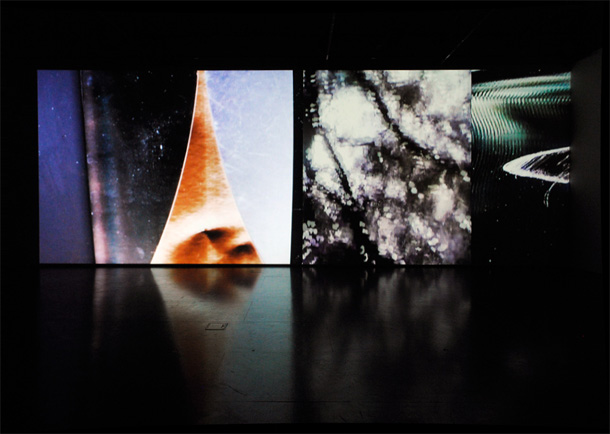
In his essay on Jena Romanticism and Zen, Dennis McCort considers the paradox of “the simultaneous embracing of transcendence and immanence”:
The idea of a state of consciousness that can get underneath the mind’s automatic categorical bifurcation of reality (inside/outside, true/false, beautiful/ugly, etc.), including even its self-bifurcation into subject and object, and seize the world directly in its primordial wholeness, is the driving power of both romanticism and Zen.[1]
For Novalis, “All being, being per se is nothing but a being-free—a hovering between extremes, which must needs be united and separated.”[2] Laura Buckley’s vast double-screen video projection, Shields, illustrates the tensions of such oscillation, as her camera wanders in hallucinatory fashion across the landscapes of her computer monitor’s images. Shield-like objects, blossom floating in a stream, metallic crystalline forms are all scrolled and probed, from macro to micro, until their likenesses entirely break apart into pixelated abstractions. We catch the occasional fleeting glimpse of the artist’s reflection in the screen, momentarily pulling us in the opposite direction, as the visceral sound of thumping electronic beats completes the sensory bombardment. At one point, a pure sine wave resonates with excessive amplitude throughout the room. It is almost impossible to withstand for any great duration, and yet the exhilaration of this exploration of newfound technological artistic empowerment is palpable.
The show’s curators refer to the notion of sleight of hand in their exhibition notes, comparing art with the field of magic and trickery. Art’s ‘magical’ operations necessarily exploit the constraints of the systems in which they operate, perhaps requiring a degree of suspension of disbelief in order to be fully realised. Here, the perceptive metamodern spectator can be seen to acknowledge the smoke and mirrors, whilst continuing to hope for the emergence of something greater than the sum of its parts: the promise that reason might be usurped by affect.
Novalis himself divided art into two main categories:
determinate art, which is guided by objects—or other central functions of the senses, is determined by concepts, finite, limited, mediated art—and indeterminate art, free, unmediated, original, not derived, cyclical, beautiful, independent, realizing pure ideas—art that is vivified by pure ideas. The former is only the means to an end—the latter is an end in itself, a satisfying activity of the spirit, self-enjoyment of the spirit.[3]
Nowhere is this quest for the “self-enjoyment of the spirit” more evident than in the video work of Guido van der Werve. Presented here is his 2005 piece, Nummer Vier, I don’t want to get involved in this, I don’t want to be a part of this, talk me out of it. “I woke up early and watched the sun rise. I felt it came up just for me,” it begins, as we see the artist gazing wistfully out to sea. Moments later, in the first of several unexpected turns, a small plane flies across the sky, trailing a banner that reads, “IT WAS NOT ENOUGH”. Next, we are treated to a recital of Chopin’s Nocturne in B-flat minor, performed by the artist on an upright piano atop a floating platform in the middle of an idyllic, mist covered lake. We then move to the surreal sight of a full orchestra and choir aboard a river barge, slowly approaching the camera, giving an impassioned rendition of Mozart’s Requiem Mass. Once the boat has passed, all is still once more, and we await the film’s end. But then, as if from nowhere, we see the artist falling from the sky with a flash, and into the river below. The overall effect of this sequence is as emotive as it is absurd, and one’s spirit cannot help but be “vivified” by the surprising conflation of beauty, slapstick and sincere romantic yearning.
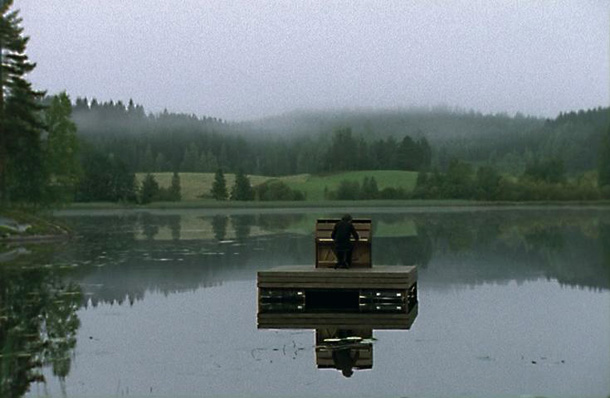
Inevitably perhaps, the show includes a few pieces that veer too obviously towards cynical deconstruction, the residue of a bygone postmodernist despondency (falling into Novalis’s “determinate art” category). James Ireland’s flimsy blue plastic bag, hung from a steel bar high up on the gallery wall, would appear to owe as much to Michael Craig-Martin’s An Oak Tree, as it does the oft-parodied ‘plastic bag dancing in the wind’ scene from Sam Mendes’s American Beauty. The work’s title, No Magic Here, seems to nail the artist’s colours to the mast. On the same wall, Damien Roach re-presents the first chapter of Bertrand Russell’s Problems of Philosophy, with every word rearranged by the artist in alphabetical order — a redundant exercise that here only serves to emphasise the miracle of effective communication by way of its very negation.
By contrast, Ryan Gander’s work once again compellingly blurs the line between intrigue and absurdity, truth and fabrication. His photograph of a note-filled cork pinboard evidences research into a series of myths surrounding Le Corbusier, including one entertaining anecdote recounting the architect’s fury at the thought of new occupants redecorating the bare walls of one of his austere modernist machines for living. On the wall beside the photograph is the physical noticeboard itself, its quasi-documentary fragments long since removed, though their shadows remain in the form of sun-bleached outlines. In this manner, one mythologising gesture tantalisingly follows another. Along similar lines, Keith Tyson’s seductively presented Magic Item Initiation Register sits in wait atop a plinth at one end of the gallery. Its title ignites a spark that quietly invites us to meditate upon its entirely blank pages, to contemplate our desire for the imperceptible, beyond and within.
In a side room, Oliver Lee Terry’s vibrant, disorientating installation is a baroque onslaught of shimmering acetate, holographic wrapping paper and spiral energy-saving light bulbs. Hidden in plain view amongst it all, in a curatorial masterstroke, is a splendidly subtle work by Susan Collis, entitled White Lies. At first, this seems to be nothing more than a tatty wooden stepladder, inadvertently left over from the show’s hanging perhaps. However, as one examines its humble form more closely, what initially appeared to be paint splodges and gluey lumps and bumps across the wooden surface, reveal themselves instead as delicately crafted inlays of precious jewels — mother of pearl, Brazilian opal, white diamond, labradorite, white howlite, moonstone — sparkling gently in the colourful light. The effect here is not one of excessive bling, but of an intimate and wondrous encounter. Satori may well remain beyond our grasp, but works such as these succeed in reminding us once more how we might experience the world as a romanticised, magical place.
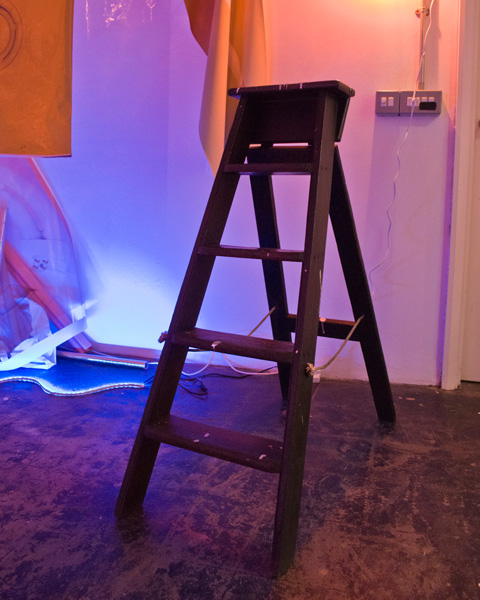
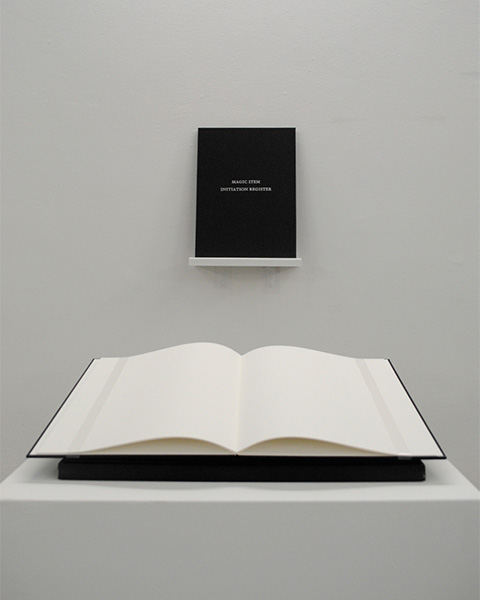
Disappearing Into One at London’s Zabludowicz Collection runs until 27th January 2013.
[1] McCort, Dennis (2005) Jena Romanticism and Zen, Discourse: Journal for Theoretical Studies in Media and Culture: Vol. 27: Iss. 1, Article 6. p. 101.
[2] Novalis. Novalis Schriften. (quoted in McCort) Ed. Paul Kluckhohn and Richard Samuel. Stuttgart: Kohlhammer, 1960–88. p. 266 .
[3] Novalis, Philosophical Writings, Trans. Margaret Mahoney Stoljar. State University of New York Press, 1997. p. 77
Images (from top): Erin Shirreff, Moon (2010)
Laura Buckley, Shields (2012)
Guido van der Werve, Nummer Vier, I don’t want to get involved in this, I don’t want to be a part of this, talk me out of it (2005)
Susan Collis, White Lies (2006)
Keith Tyson, Magic Item (Black) (2000)
All works © the artists.
Installation photos by Stephanie Neoh, courtesy the Zabludowicz Collection.
